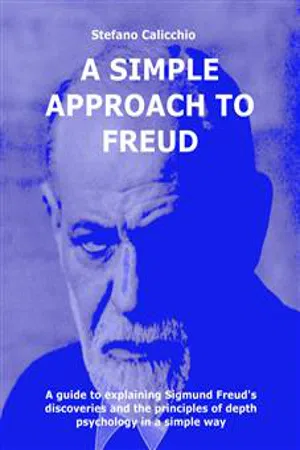
A simple approach to Freud
A guide to explaining Sigmund Freud's discoveries and the principles of depth psychology in a simple way
- English
- ePUB (mobile friendly)
- Available on iOS & Android
A simple approach to Freud
A guide to explaining Sigmund Freud's discoveries and the principles of depth psychology in a simple way
About this book
What are the foundations of psychoanalysis? What were the ideas and discoveries at the basis of this discipline? How did Freud manage to discover the principles of the functioning of the human mind? This book was created with the idea of offering the reader a clear and simple perspective on the discoveries that led to the birth of depth psychology. Inside you will discover the principles of psychodynamic theory. From the birth of depth psychology to the first clinical findings related to the use of hypnosis, and on to the unconscious psychic mechanisms that regulate people's lives. The method of investigation used by Freud to connect the different psychic layers present in the individual will also be illustrated. The reader will thus be able to follow a path of discovery that will not only enable him to better understand the subject, but also to question himself and the basic postulates that regulate psychic life.
Frequently asked questions
- Essential is ideal for learners and professionals who enjoy exploring a wide range of subjects. Access the Essential Library with 800,000+ trusted titles and best-sellers across business, personal growth, and the humanities. Includes unlimited reading time and Standard Read Aloud voice.
- Complete: Perfect for advanced learners and researchers needing full, unrestricted access. Unlock 1.4M+ books across hundreds of subjects, including academic and specialized titles. The Complete Plan also includes advanced features like Premium Read Aloud and Research Assistant.
Please note we cannot support devices running on iOS 13 and Android 7 or earlier. Learn more about using the app.
Information
Self-assessment test
-
The set of elements that make up the human brain.
-
The set of forces present in each person that are in conflict with each other.
-
The rational part of the mind and its implications in everyday life.
-
Mental illness from the point of view of physiological effects.
-
a key role in the early phase of development.
-
A key role in the final stage of development.
-
An irrelevant role.
-
A role never clearly defined by historical and scientific research.
-
The method of open-mindedness.
-
The physiological intervention method.
-
The catharsis method.
-
The primary and secondary method of intervention.
-
The metaphor of the reality check.
-
The iceberg metaphor.
-
The metaphor of the Oedipus complex.
-
None of these solutions are correct.
-
Impossible to observe directly.
-
Directly observable.
-
Uncategorisable for psychoanalysis.
-
Unfathomable until a state of healing is achieved.
-
a specific erogenous zone.
-
A specific area of the brain.
-
The type of environment in which man finds himself.
-
A set of unfathomable elements.
-
The functioning of psychic processes in the conscious.
-
The functioning of psychic processes in the unconscious.
-
The functioning of psychic processes present in all living beings.
-
The functioning of psychic processes in human beings.
-
Synthetic, complex and mixed;
-
Economic, dynamic and topical.
-
Current, past and future.
-
None of these.
-
The preservation of the proof of reality.
-
Failure to preserve evidence of reality.
-
The illusion of being able to preserve the proof of reality.
-
Access to unconscious thoughts, which are removed in psychosis.
-
A displacement of affection through a conscious process.
-
A displacement of affection through an unconscious process.
-
The removal of affection due to the trauma suffered.
-
none of these answers is correct.
Solutions
- 2
- 1
- 3
- 2
- 1
- 1
- 4
- 2
- 1
- 2
Table of contents
- Cover
- A SIMPLE APPROACH TO FREUD
- Table of contents
- Introduction
- Freud and the birth of depth psychology
- The birth of psychoanalysis
- The language of dreams and psychic determinism
- Mental life according to Freud and the birth of the unconscious
- The start of the psychoanalytic movement
- The functioning pattern of the mind according to depth psychology
- Drive theory and the role of sexuality
- Human development and the child's drive phases
- Child development: the oral phase
- Child development: the anal phase
- Child development: the phallic phase
- Child development: the latent and genital phase
- Defence mechanisms
- Meta-psychology and drive theory
- The dynamic point of view
- The topical point of view
- Developments in drive theory
- Neurosis and psychosis in the psychoanalytic process
- The concept of transference in psychoanalysis
- Developments in psychoanalysis
- Conclusion
- The key points of this guide
- Self-assessment test
- Solutions